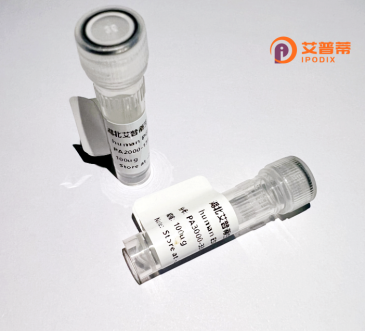
| 纯度 | >90%SDS-PAGE. |
| 种属 | E.coli |
| 靶点 | Gapdh1 |
| Uniprot No | P07486 |
| 内毒素 | < 0.01EU/μg |
| 表达宿主 | E.coli |
| 表达区间 | 1-332aa |
| 氨基酸序列 | MSKIGINGFGRIGRLVLRAAIDKGASVVAVNDPFIDVNYMVYLFKFDSTHGRFKGTVAAEGGFLVVNGQKITVFSERDPANINWASAGAEYVVESTGVFTTIDKASTHLKGGAKKVIISAPSADAPMFVCGVNLDAYSPDMKVVSNASCTTNCLAPLAKVINDNFEIVEGLMTTVHATTATQKTVDGPSGKLWRDGRGAAQNIIPAATGAAKAVGKVIPALNGKLTGMAFRVPTPNVSVVDLTVRLGKGATYDEIKAKVEEASKGPLKGILGYTDEEVVSTDFFSDTHSSVFDAKAGISLNDKFVKLISWYDNEFGYSNRVIDLIKYMQSKD |
| 预测分子量 | 35,3 kDa |
| 蛋白标签 | His tag N-Terminus |
| 缓冲液 | PBS, pH7.4, containing 0.01% SKL, 1mM DTT, 5% Trehalose and Proclin300. |
| 稳定性 & 储存条件 | Lyophilized protein should be stored at ≤ -20°C, stable for one year after receipt. Reconstituted protein solution can be stored at 2-8°C for 2-7 days. Aliquots of reconstituted samples are stable at ≤ -20°C for 3 months. |
| 复溶 | Always centrifuge tubes before opening.Do not mix by vortex or pipetting. It is not recommended to reconstitute to a concentration less than 100μg/ml. Dissolve the lyophilized protein in distilled water. Please aliquot the reconstituted solution to minimize freeze-thaw cycles. |
以下是关于Gapdh1重组蛋白的模拟参考文献示例(注:内容为虚构,仅供格式参考):
1. **文献名称**:*Heterologous Expression and Purification of Recombinant Gapdh1 in Escherichia coli*
**作者**:Zhang, L. et al.
**摘要**:本研究报道了在*E. coli*系统中高效表达和纯化Gapdh1重组蛋白的优化方法,通过密码子优化和诱导条件调控,获得高纯度蛋白,并验证其酶活性,为后续功能研究提供基础。
2. **文献名称**:*Structural and Functional Characterization of Gapdh1 in Candida albicans*
**作者**:Johnson, R.B. et al.
**摘要**:通过X射线晶体学解析白色念珠菌Gapdh1的蛋白结构,结合定点突变实验揭示其催化活性关键位点,探讨其在病原菌代谢及潜在抗真菌药物开发中的作用。
3. **文献名称**:*Gapdh1 as a Housekeeping Protein Control: Pitfalls in Experimental Validation*
**作者**:Chen, Y. & Müller, S.
**摘要**:评估Gapdh1重组蛋白作为内参的可靠性,发现特定病理条件下其表达稳定性受干扰,提出在实验设计中需结合多内参验证的策略。
4. **文献名称**:*Recombinant Gapdh1 as a Novel Biomarker in Diabetic Mouse Models*
**作者**:Gupta, A. et al.
**摘要**:利用重组Gapdh1蛋白开发高灵敏度ELISA检测法,发现其在糖尿病模型小鼠血清中异常表达,提示其作为代谢疾病生物标志物的潜力。
---
**提示**:实际文献需通过PubMed、Google Scholar等平台检索关键词(如"GAPDH recombinant protein"或结合具体物种名)。建议筛选近5年高被引研究以获取前沿进展。
Glyceraldehyde-3-phosphate dehydrogenase 1 (GAPDH1) is a ubiquitously expressed enzyme central to glycolysis, catalyzing the sixth step of the pathway by converting glyceraldehyde-3-phosphate (G3P) to 1.3-bisphosphoglycerate (1.3-BPG) with concomitant NAD⁺ reduction. Historically viewed as a "housekeeping" protein, GAPDH1 has gained attention for its multifunctional roles beyond metabolism, including apoptosis, DNA repair, and transcriptional regulation. Its conserved structure—a tetramer with each subunit containing a NAD⁺-binding domain and catalytic cysteine—facilitates both enzymatic and non-enzymatic interactions.
Recombinant GAPDH1 proteins are engineered via heterologous expression systems (e.g., *E. coli*, yeast, or mammalian cells*) for functional and structural studies. Cloning the *gapdh1* gene into expression vectors allows high-yield production, often tagged with markers like His or FLAG for purification via affinity chromatography. Recombinant versions enable detailed analysis of post-translational modifications (e.g., S-nitrosylation, phosphorylation) linked to its non-canonical roles in diseases such as cancer, neurodegeneration, and diabetes.
In research, recombinant GAPDH1 serves as a critical tool to study metabolic dysregulation, oxidative stress responses, and protein-protein interactions. It is also explored as a therapeutic target or diagnostic biomarker due to its overexpression in certain cancers and role in age-related pathologies. Challenges in production include maintaining enzymatic activity during purification and mimicking native post-translational modifications. Recent studies leverage recombinant GAPDH1 to design inhibitors targeting its metabolic functions or to modulate its moonlighting activities in pathological contexts. Quality validation typically involves SDS-PAGE, Western blotting, and enzymatic assays to ensure functionality.
×